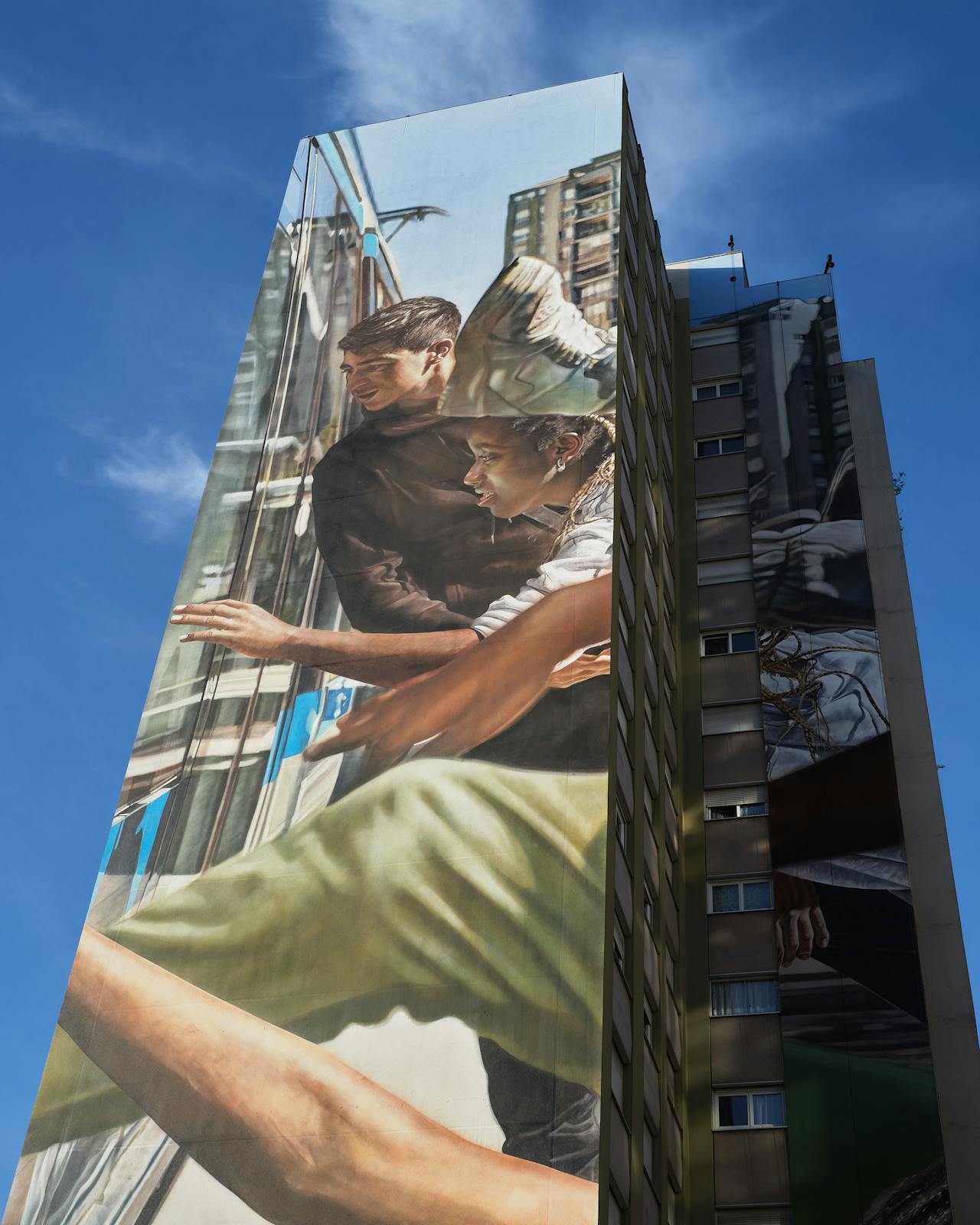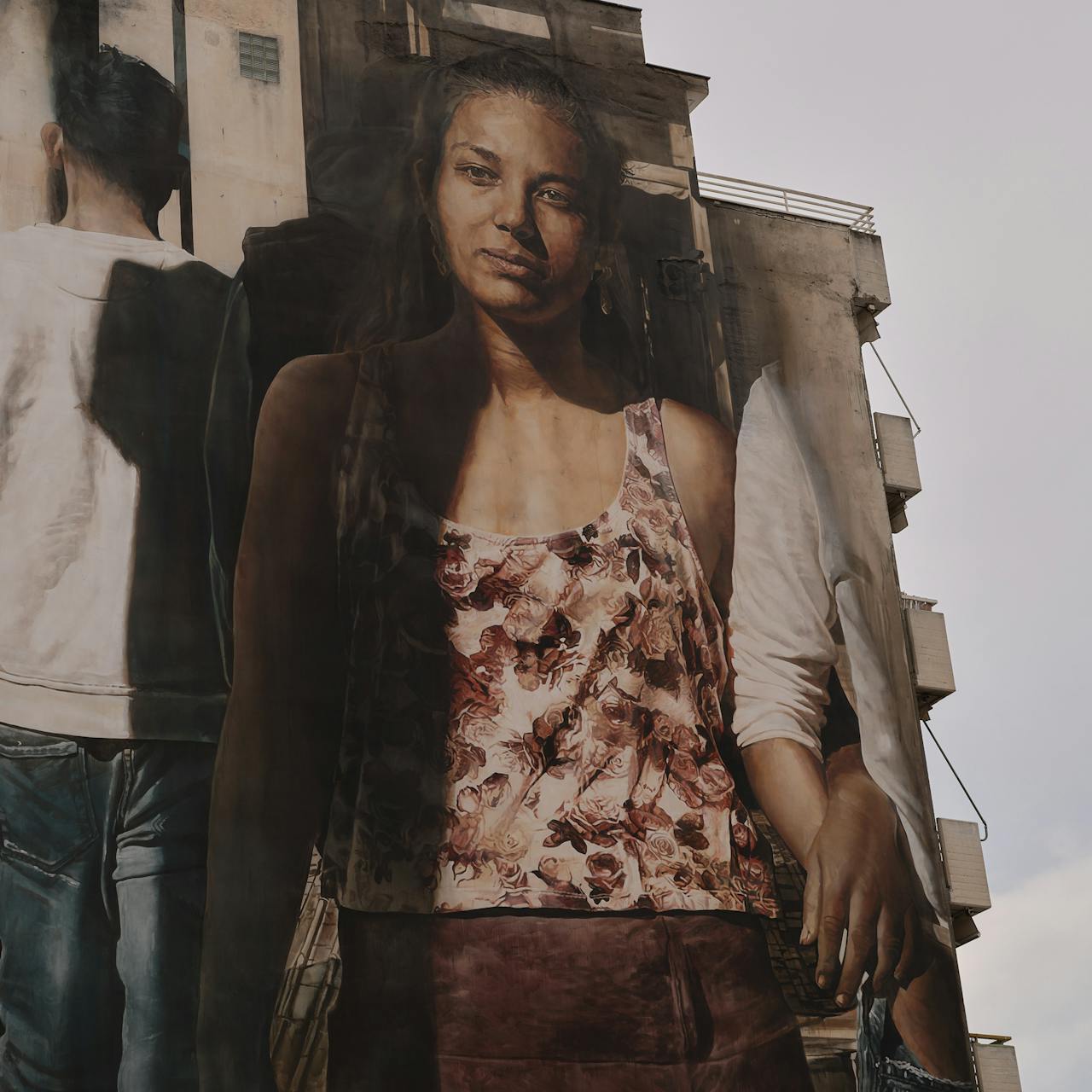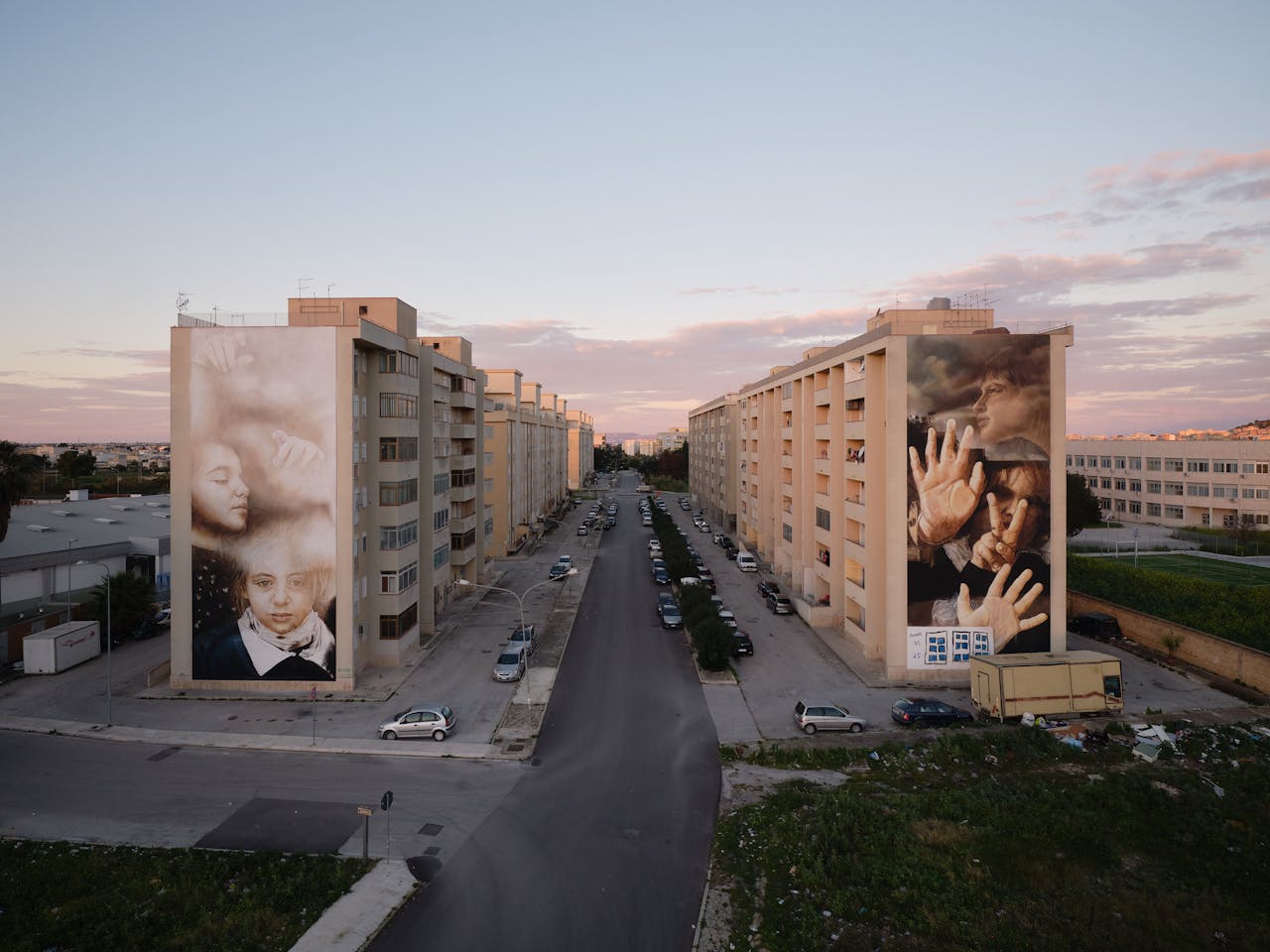Zarzew - Fundacja Urban Forms
Łódź, Poland,
2019
Installation completed for Fundacja Urban Forms, Łódź, Poland. July 2019 Photograph: Guido van Helten
Painted in the Zarzew district of Łódź, this diptych mural is a study of the post-Soviet explosion of colour on Poland’s concrete apartment blocks known as ‘pasteloza,’ and the value of personal art in the home versus murals in the public space.
Photographs by Guido van Helten
Project Details
Project
Zarzew - Fundacja Urban FormsLocation
Łódź, PolandCommissioner
Fundacja Urban FormsResident of the housing blocks and an ornamental art piece. Łódź, Poland. July 2019 Photograph: Guido van Helten
This project was commissioned by Urban Forms to repair a pair of damaged murals, originally painted in 2014 on two resident tower blocks by artists Cekas Berger, SEPE, Daniel Chazme, Krzysztof Syruc (Proembrion), and the late Robert Proch. With over one hundred murals the Polish city of Łódź has become renowned for its vibrant street art and culture scene, and residents of the Zarzew towers were keen to work with Urban Forms for the murals in their block to be renovated.
Guido van Helten met with the residents in order to encourage their participation in the project and to generate photographic studies as the basis for the new mural’s design. Residents were asked to share favourite pieces of art kept in their own homes, in response to the question: What is your idea of art in the home versus art in the public space? The artist then photographed residents and the paintings, statues, and other art objects in their possession, while getting to know the personal stories behind the subjects’ selections. Nostalgia, faith, and sentiment were some of the many reasons why these domestic works hold so much value – opening up a dialogue within the community about the value of murals in public space.
The Black Madonna. Częstochowa, Poland. July 2019 Photograph: Guido van Helten
Ornamental copies of the Black Madonna. Częstochowa, Poland. July 2019 Photograph: Guido van Helten
Van Helten’s resulting diptych explores this theme of public and private value, depicting glimpses of local residents he photographed as well as reproductions of some of the artworks they shared – including a painting titled “Łeba” by a little boy called Tymek. In line with the public/private theme, the artist also sought to achieve a harmony with the buildings’ existing pastel colour palette – a leftover from the post-Soviet repainting of public housing known as pasteloza.
Resident of Zarzew and prized art piece. Łódź, Poland. July 2019 Photograph: Guido van Helten
Resident of Zarzew and prized art piece. Łódź, Poland. July 2019 Photograph: Guido van Helten
Resident of Zarzew and prized art piece. Łódź, Poland. July 2019 Photograph: Guido van Helten
Resident of Zarzew - a young man in uniform. Łódź, Poland. July 2019 Photograph: Guido van Helten
Sara Nikolic, Urban Development Issues (Vol 63, Issue 1, 2019), Pasteloza: refurbishing of the PPR heritage.
Krisztine Fehervary (2013), Politics in Colour and Concrete: Socialist Materialities and the Middle Class in Hungary, page 1.
Eliza Otto, (April 2007), Pastelosis – kitsch or tradition?
Following the end of the Soviet era, pasteloza represented a desire for freedom of aesthetic expression in the public sphere. From 1990 Poland’s changing political regime motivated transformations to the urban environment, altering street names and removing sculptures and other symbolic references to the former Soviet occupation of public space.1 During the Cold War era, Westerners often invoked the ‘greyness’ of Eastern Europe as a shorthand for socialist scarcity, while colour signified the pleasures and possibilities of consumption and choice.2 But in Poland and other Eastern bloc countries, greyness came to symbolise an absence of political freedom, more so than a lack of consumer goods – and there was no more potent a symbol than the famously drab, uniform, and monotonous Brutalist Soviet-era housing blocks. When it became necessary to repair and insulate the old apartment buildings in Łódź and elsewhere, many residents opted to repaint their facades in a whole spectrum of colours as another act of reclaiming public space and personal freedom. As Eliza Otto explains, pasteloza became a small act of power for residents deciding for themselves how they wanted their immediate surroundings to look.3
Resident of Zarzew and painted image used in the final artwork. Łódź, Poland. July 2019 Photograph: Guido van Helten
Examples of 'pasteloza' - Zarzew housing blocks. Łódź, Poland. July 2019 Photograph: Guido van Helten
But the evolving legacies of pasteloza are complicated, as indeed are the legacies of Soviet-era Poland. Nostalgia competes with progressivism. For some, the apartment towers (even the repainted ones) are domineering, outdated and even kitschy reminders of the Soviet and immediate post-Soviet past in a rapidly gentrifying city, while for others such dismissiveness overshadows the otherwise extraordinary social achievements of mass public housing and of Poland’s political past.
Such tensions can be discerned in the interventions of murals and other street art in Łódź’s ongoing redevelopment. Van Helten’s mural is itself situated on walls that are simultaneously private and public, containing family homes on the inside and providing artistic and architectural interest from the outside. But through its content and form, the mural was intended to find ways of integrating rather than smoothing over this tension. The existing pasteloza colours are incorporated through the artist’s style within the framework of the image, alongside the more vivid palettes seen in the reproductions of the residents’ private artworks – bringing together both individual and communal expressions of creative freedom in the public sphere.
Work in progress - Zarzew housing blocks. Łódź, Poland. July 2019 Photograph: Paweł Trzeźwiński
Guido van Helten, artist notes.
I played with the harmony of my own work this time with the unusual use of pastel colours in an already saturated environment. I tried to condense the pastels into a saturation within the framework of the image, reproducing on a large scale the abstract expressions of the residents on a large scale, bringing the residents’ private art into the public realm.4
Finishing Łeba - Zarzew housing blocks. Łódź, Poland. July 2019 Photograph: Paweł Trzeźwiński
Resident of Zarzew housing block. Łódź, Poland. July 2019 Photograph: Guido van Helten
Tymek and his painted image of Łeba used in the final artwork. Łódź, Poland. July 2019 Photograph: Guido van Helten
Finishing Łeba - Zarzew housing blocks. Łódź, Poland. July 2019 Photograph: Paweł Trzeźwiński
'Łeba' replicated within the mural. Łódź, Poland. July 2019 Photograph: Guido van Helten
Finished murals - Zarzew housing blocks. Łódź, Poland. July 2019 Shot and Edited: Guido van Helten
Gold Stadt (City of Gold)
Pforzheim, Germany, 2023
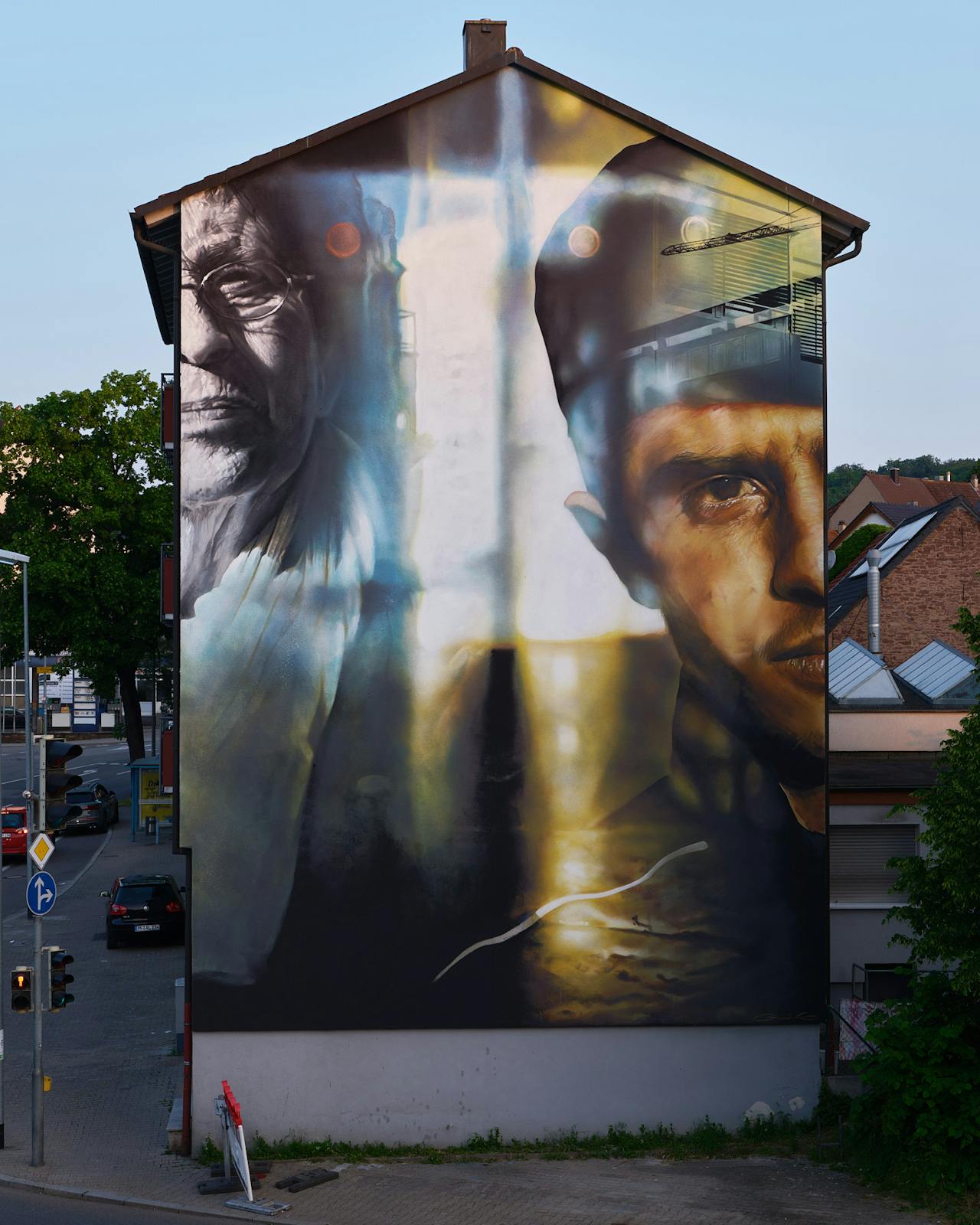
Gold Stadt (City of Gold) conjures thoughts of destruction and...
Bookbinders in Exarcheia
Exarcheia, Athens, Greece, 2021
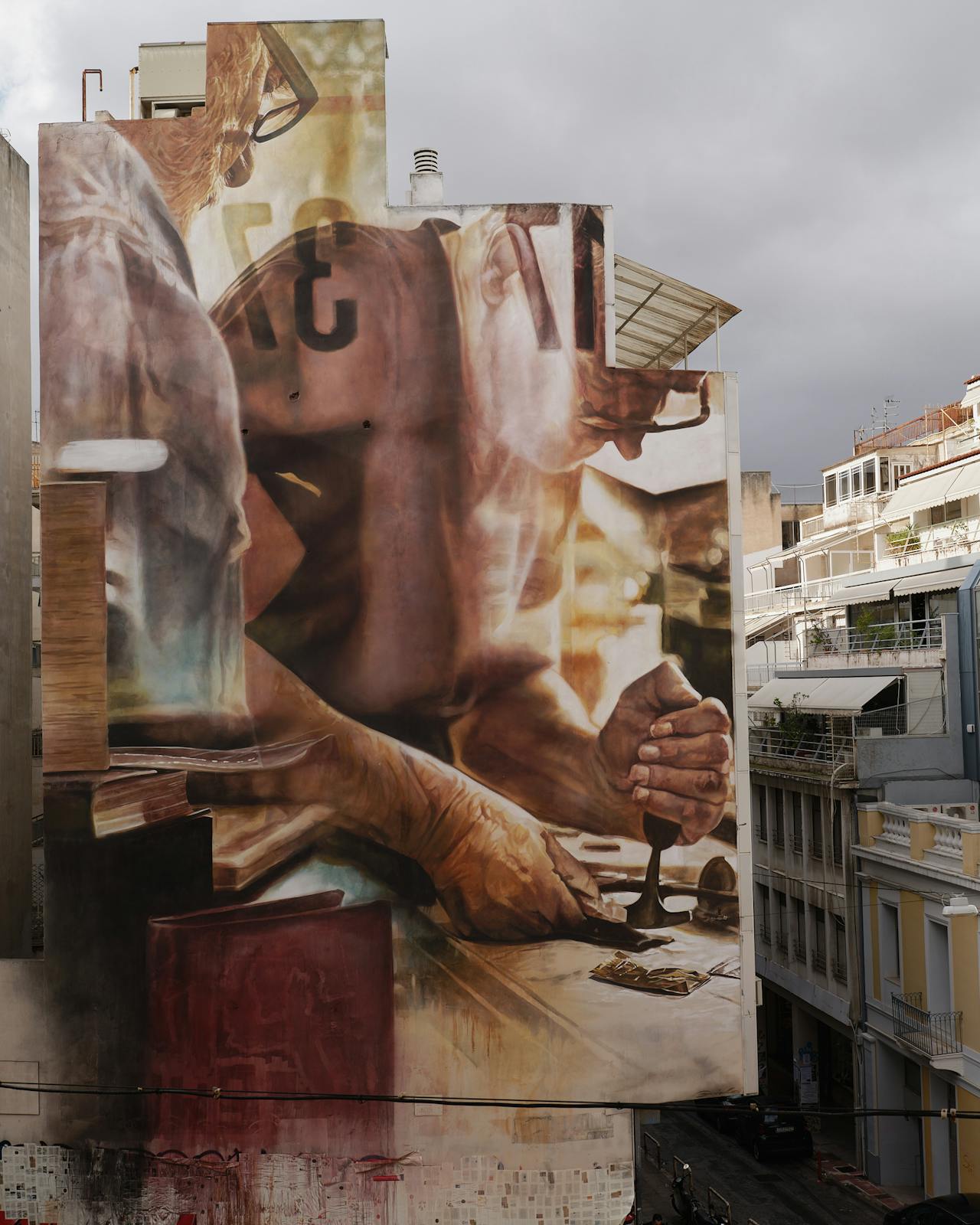
This work explores the collective identity of Exarcheia, a central...
YYC Bump
Calgary, Canada, 2019
Exploring the shared iconographic relationships and cultural usage...
Hold Water I
Azraq, Jordan, 2019
Installed on a water tower in the small community of Azraq, Jordan,...
Southern Cross University
Gold Coast, Australia, 2018
In early 2018 I was invited to create a mural at the Gold Coast...
Solar de Samaniego
Laguardia, Spain, 2016
Commissioned by Solar de Samaniego winery in the wine producing...
Melbourne Polytechnic
Melbourne, Victoria, Australia, 2017
This work visually explores the interaction of human stories and...
UPEA Festival I
Helsinki, Finland, 2016
Muistot Unelmien'(Remembering a Dream) Painted in Helsinki Finland...
A Portrait of an Artist: Collaboration with Selina Miles
Grímsey, Iceland, 2015
In August 2015, film director Selina Miles travelled with artist...
Back Alley Gallery
Lismore, New South Wales, 2016
Titled 'Willow' after the subject of the painting this piece was...
Urban Myths
Minsk, Belarus, 2015
In late 2015 I was invited to participate in the Urban Myths...
Lily of the Valley
Kiev, Ukraine, 2015
конвалія (Lily of the Valley) painted as part of CityArt project in...
Akureyravaka
Akureyri, Iceland, 2014
'Painted for Akureyrarvaka Menningarnótt (culture night) in 2014...
















